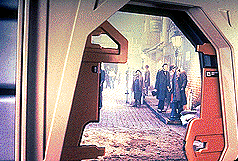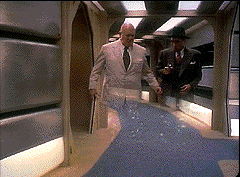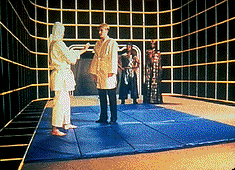 |
|
 |
|
|
|
|
|
The holodeck, also known as a Holographic Environment Simulator, is an extremely advanced cross pollination of several technologies. Incorporating force fields, matter replication, narrow focus tractor beams, transporters, and holographic projection, the holodeck recreates with precise fidelity any environment that can be programmed into a computer database.
The holodeck, also called a holosuite when in a smaller ratio, is usually a small room with its walls, ceiling and floor covered with holo-emitters. These small devices control and alter the environment with tightly packed equipment from all the technology fields mentioned earlier.
Holographic projections are used to create the overall environment, giving the user the illusion of being in wide open spaces or cramped crawlways while matter replication is used to create objects or subjects with which the user can interact. When more interaction is required than simple tables or trees, narrow band tractor beams and force fields are used to manipulate replicated matter, giving the illusion of movement or life. In the case of replicated humanoids or 'living beings', the tractor beams and force fields push and pull the inert matter, much like a puppeteer or marionette. The precise control attainable can give the illusion that a replicated creature is very much alive, down to such subtle nuances such as respiration, blinking, twitching, and so on.
Unfortunately, holodecks have their drawbacks. In order to replicate and control vast amounts of matter with such fine precision, matter on the holodeck is only partially stable. While in the confines of the holodeck, it has all the characteristics of regular matter, but if removed, the matter loses its molecular cohesion and disintegrates.
There is also the danger of the holodeck computer becoming confused as to who or what is a holodeck generated simulacrum and who or what is a sentient being. While no cases of fatalities have been recorded in this regard, the danger is still present and is seen as a major drawback to an otherwise marvelous technology. Other dangers include holodiction, the psychological condition in which a sentient becomes so engrossed in a holodeck environment that the "lines" between reality and imagination become blurred or unimportant. Addiction to a holographic simulation is harmful and can disrupt an individual's life, requiring counseling and treatment.
Holodecks are an invaluable tool for long duration space missions and are standard equipment on most modern Starfleet starships. |
 Holodeck Door  Holomatter  Hologrid |
| Resource By: | |
| Posted: |
2003.02.20 |
|
|
|
|
|
|
|
 |
. |
 |
|


|







